Architecture of Liverpool
The architecture of Liverpool is rooted in the city's development into a major port of the British Empire.[1] It encompasses a variety of architectural styles of the past 300 years, while next to nothing remains of its medieval structures which would have dated back as far as the 13th century.[2] Erected 1716-18, Bluecoat Chambers is supposed to be the oldest surviving building in central Liverpool.[3]
There are over 2,500 listed buildings in Liverpool of which 27 are Grade I and 85 Grade II* listed.[4] It has been described by English Heritage as England's finest Victorian city.[5] However, due to neglect, some of Liverpool's finest listed buildings are on English Heritage's Heritage at Risk register.[6]
In accordance with Liverpool's role as a trading port, many of its best buildings were erected as headquarters for shipping firms and insurance companies. The wealth thus generated led to the construction of grand civic buildings, designed to allow the local administrators to "run the city with pride".[7]
The historical significance and value of Liverpool's architecture and port layout was recognised when, in 2004, UNESCO declared large parts of the city a World Heritage Site. Known as the Liverpool Maritime Mercantile City, the nomination papers stress the city's role in the development of international trade and docking technology,[8] summed up in this way under Selection Criterion iv: "Liverpool is an outstanding example of a world mercantile port city, which represents the early development of global trading and cultural connections throughout the British Empire."[9]

Chronology and Styles
Medieval
Liverpool's origins date back as far as the 11th century, although today nothing remains of the city's medieval architecture. Probably the earliest building of note within Liverpool would have been Liverpool Castle, which was constructed between 1232 and 1235 by William de Ferrers.[1] The oldest surviving building within the city is likely to be Stanlawe Grange in Aigburth, a Monastic grange dating from the 13th century. Frequent modifications throughout its history mean that little of the original building remains, although sections of it are believed to date from 1291.[10] Despite the lack of many physical remnants of this period, the city's medieval history is still evident in the street patterns around Liverpool Town Hall, with all seven of the city's original streets remaining in approximately the same position today.
Tudor and Elizabethan
Like medieval architecture before it, little remains of Tudor and Elizabethan architecture in Liverpool today. Speke Hall, which is located in the south of the city, is a Tudor manor house that dates from the 16th century. It was completed in 1598, although much of the building dates from much earlier in the century.[11] It is one of the few remaining timber framed Tudor houses in the North of England and it is noted for its Victorian interior.[12]
Another large manor house that dates from this period is Croxteth Hall, the ancestral home of the Molyneux family. Started in 1575, only one wing of the building actually dates from this period, with the majority of the house completed during the 18th and 19th centuries.[13] As such the building mixes a variety of different architectural styles including Elizabethan, Queen Anne Style and Georgian.[14]
-

Speke Hall (1530–98; Grade I)
-

Croxteth Hall (1575; Grade II*)
Stuart
Several buildings from the Stuart era remain in Liverpool today, with the oldest of them, Tuebrook House, dating from 1615.[11] The Ancient Chapel of Toxteth also dates from this period and was likely started around 1618. The building is today grade I listed and still serves its original purpose as a Unitarian Chapel.[15]
One of the period's most notable remaining buildings is Woolton Hall, a grade I listed manor house located in the south of the city. Also built for the Molyneux family, the hall is conceived as a Palladian villa and constructed from red sandstone from the local quarry in Woolton.[13]
Mainly built in 1716–17, but with additions nearly immediately necessary, Bluecoat Chambers is the oldest surviving building in Liverpool city centre. Designed in the Queen Anne style, following in the tradition of Christopher Wren, it housed the Liverpool Blue Coat School. After the schools moved to new premises in 1906, Bluecoat Chamber faced the possibility of being demolished several times. Following war damage in 1941, the reconstructed building was grade I listed in 1952.[16]
-
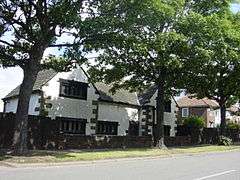
Tuebrook House (1615; Grade II*)
-

Toxteth Unitarian Chapel (1618; Grade I)
-

Woolton Hall (1704; Grade I)
(engraving of 1819) -
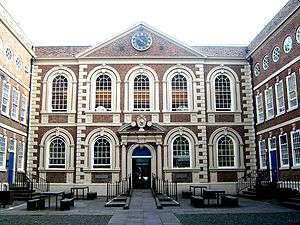
Bluecoat Chambers
(1717; Grade I) -

Bluecoat Chambers
garden elevation
Georgian
The expansion of the city into an international sea port from the 17th century onwards and the resulting transatlantic trade, particularly in slaves, brought wealth to Liverpool. Over time, this wealth manifested itself in a number of elegant town houses, many of which are still preserved today.
Liverpool Town Hall was built between 1749 and 1754 to a design by John Wood the Elder replacing an earlier town hall nearby. It was significantly extended and altered by James Wyatt from 1785. Its sumptuous interiors are highly regarded examples of late Georgian architecture. The city's stock exchange and financial district are set immediately behind this building, showing the close ties between local government and commerce.
The Anglican Church of Our Lady and St Nicholas is Liverpool's parish church. Colloquially known as "the sailors' church", it has existed near the waterfront since 1257. The current building, designed by Thomas Harrison, was begun in 1811 following the castastrophic collapse of the old tower. While Harrison's tower is still original, the main body of the church has been rebuilt following Second World War damage.
Some of Liverpool's landmarks are mainly known for their oddness, such as the Williamson Tunnels which are architecturally unique as the largest underground folly in the world.
-

Liverpool Town Hall
(1754; Grade I) -

Liverpool Town Hall
Dome -
.jpg)
62 Mount Pleasant (1767; Grade II)
-

Georgian townhouses
Rodney Street -

Rodney Street
(1784; Grade II)
Number 62, the birthplace of Gladstone, is Grade II* -
.jpg)
66 Mount Pleasant (1788; Grade II)
-

1 Trueman Street (1788; Grade II)
-

Liverpool Royal Institution (1799; Grade II)
-
Clarke's Basin cottages, Old Hall Street (1800; Grade II)
-

Union News Room (1800; Grade II)
-

Heywood's Bank (1800; Grade II) one of the earliest purpose-built banks
-

Abercromby Square
(1820s; Grade II) -

Percy Street
(1830s; Grade II*) -

Huskisson Street
(1830s; Grade II*)
Neo-Classical
Liverpool has a rich tradition of neo-classical architecture running through the Georgian right to the end of the Victorian period. Some prime early examples are the Lyceum by Thomas Harrison (1802), Wellington Rooms by Edmund Aikin (1815–16; a grade II* listed building, now at risk in a "very bad" condition[17]) and The Oratory by John Foster (1829). Also impressive is the grade I listed Bank of England Building built by Charles Robert Cockerell between 1845–1848.[18]
The unique ensemble of High Victorian neo-classical buildings around William Brown Street has been labelled the city's "Cultural Quarter". Located here are the William Brown Library and Museum (opened 1860; it now houses the World Museum Liverpool and Liverpool Central Library), Picton Library (1879) and Walker Art Gallery (1877). Not strictly a neo-classical design and much closer to Beaux-Arts architecture, the County Sessions House (1884) next to the Walker fits in with its more playful classical vocabulary. Dominating the area, the magnificent St George's Hall was built 1841–54 to a design by Harvey Lonsdale Elmes and completed by C.R. Cockerell. It served a variety of civic functions, including that of a concert hall and as the city's law courts. Alluding to the ancient Roman SPQR, its doors are inscribed with the letters S.P.Q.L. (initials for the Latin phrase Senatus PopulusQue Liverpudliensis—"the senate and people of Liverpool"). Together with its grand architecture this proclaims the municipal pride and ambition of the city in the mid-19th century. Also nearby are Wellington's Column and the Steble Fountain.
-
The Lyceum
(1802; Grade II*)
Europe's first lending library -

Wellington Rooms
(1816; Grade II*) -

The Oratory
(1829; Grade I) -
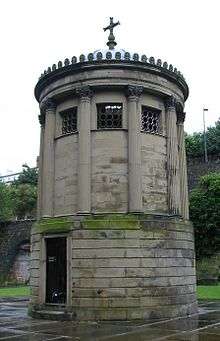
Monument to William Huskisson
(1834; Grade II)
at St James Cemetery
(1829; Grade I) -

St. Bride's Church
(1830; Grade II*)
Georgian Quarter -

Liverpool Medical Institution
(1837; Grade II*) -
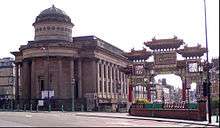
Great George Street Congregational Chapel
(1841; Grade II), nicknamed The Blackie, by City Architect Joseph Franklin,[1]
and Chinese Arch (2000) – the largest outside of China -
Bank of England
(1848; Grade I) -
Dock Traffic Office
(1848; Grade I) -

St. George's Hall
(1854; Grade I)
one of the finest neo-classical buildings in the world -

William Brown Library and Museum
(1860; Grade II*) -
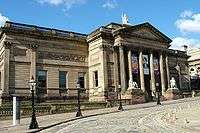
Walker Art Gallery
(1877; Grade II*) -

Picton Library
(1879;Grade II*)
first electrically-lit library in the UK -
County Sessions House
(1884; Grade II*)
Victorian

The docks are central to Liverpool's history, with the best-known being Albert Dock. Designed by Jesse Hartley and constructed in cast iron, brick and stone, it provides the first enclosed, non-combustible dock warehouse system in the world. Restored in the 1980s, the Albert Dock has the largest collection of Grade I listed buildings in Britain. Part of the old dock complex is now the home to the Merseyside Maritime Museum (an Anchor Point of ERIH, The European Route of Industrial Heritage), the International Slavery Museum and the Tate Liverpool. Other relics of the dock system include the Stanley Dock Tobacco Warehouse, which at the time of its construction in 1901, was the world's largest building in terms of area, and is still the world's largest brick-work building.
Peter Ellis was an obscure architect and civil engineer who, nevertheless, designed the pioneering Oriel Chambers (1864) in Water Street as "one of the first office buildings to be clad in glazed curtain-walling"[9] in its rear courtyard. Well ahead of its time, the building was severely criticized in The Builder of 16 June 1866 as a "large agglommeration of protruding plate-glass bubbles", a "vast abortion" without any aesthetic qualities.[19] In all likelihood, however, it was studied by young John Wellborn Root who spent some time in Liverpool to escape the American Civil War just when Ellis' building had been finished. Root took some of Ellis' ideas back to America where he later became an important architect of the Chicago School of Architecture. Oriel Chambers therefore played an important role in the development of the skyscraper. Ellis' only other known building, 16 Cook Street, Liverpool, dates from 1866 and also features a curtain wall in its rear courtyard.
Born in Aigburth, Liverpool, architect Alfred Waterhouse established practices in Manchester and later in London. He achieved national fame for a large number of mostly institutional, commercial and educational buildings throughout England. He also designed several structures for his home city, including the University of Liverpool's Victoria Building, completed in 1892. Waterhouse's use of striking red brick and tiles as building materials for its exterior inspired Edgar Allison Peers, a Spanish professor at Liverpool, to coin the term Red Brick University and to then apply it collectively to six recently founded institutions of higher education in some of the major industrial cities of England.[20] Another important Waterhouse complex is the Liverpool Royal Infirmary (1886–92).
Victorian Liverpool's notable places of worship include the Greek Orthodox Church of St Nicholas (built in the Neo-Byzantine architecture style), the Gustav Adolf Church (the Swedish Seamen's Church, reminiscent of Nordic styles) and the Welsh Presbyterian Church. Having a Jewish community since the mid-18th century, Liverpool has several synagogues. The grade I listed Princes Road Synagogue in the Moorish Revival style is architecturally the most important.[21] Two further orthodox synagogues are in the Allerton and the Childwall district, where a significant Jewish community resides.[22]
The Philharmonic Dining Rooms on Hope Street not only have a flamboyant exterior and intricate internal decor but are also noteworthy for their ornate Victorian toilets, which have become a tourist attraction in their own right.
-

Gambier Terrace
(1837; Grade II*) -

Royal Bank Building,
18 Queen Avenue
(1839; Grade II*) -

Queen Insurance Building (1839; Grade II)
-

North and South Wales Bank (1840; Grade II) and Alliance Bank (1868; Grade II)
-
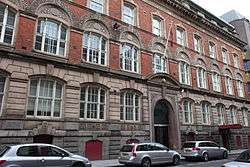
The Albany
(1856; Grade II*) -

Liverpool, London and Globe Building
by Charles Robert Cockerell
(1858; Grade II) -

Union Marine Building (1859; Grade II)
-
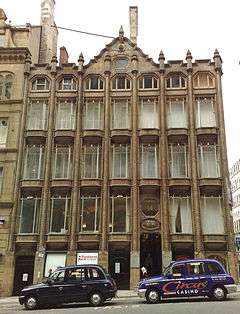
Oriel Chambers
(1864; Grade I) -
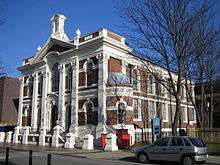
Chatham Building
University of Liverpool
(1865; Grade II) -

16 Cook Street
(1866; Grade II*) -
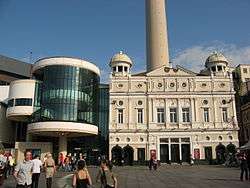
Playhouse Theatre
(1866; Grade II*)
(modern extension 1968) -

Compton House
(1867; Grade II)
First purpose-built department store in the UK -

Municipal Buildings
(1868; Grade II*) -

Fowler's Building
(1869; Grade II*) -
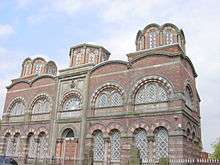
Greek Orthodox Church of St Nicholas
(1870; Grade II) -
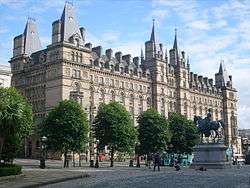
Great North Western Hotel
Lime Street
(1871; Grade II) -
Conservative Club (1883; Grade II)
-

Gustav Adolf Church
(1883; Grade II*)
Oldest Swedish church outside of Sweden -

Royal Infirmary
(1886–92) -

Royal Infirmary
(1886–92) -

Victoria Building
University of Liverpool
(1892; Grade II) -

Adelphi Bank
Castle Street
(1892; Grade II*) -
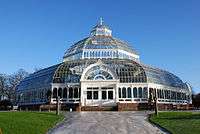
The Palm House
Sefton Park
(1896; Grade II*) -
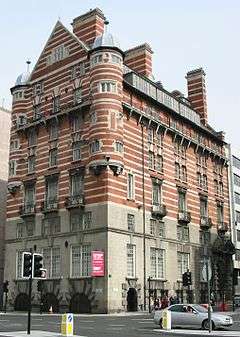
Albion House
(1898; Grade II*)
Former headquarters of the White Star Line -

The Philharmonic Dining Rooms
(1900; Grade II*) -

Museum Extension and Central Technical School
(1901; Grade II*) -
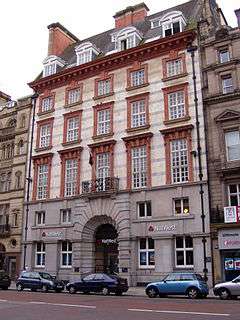
National Westminster Bank
Castle Street
(1901; Grade II*)
20th century
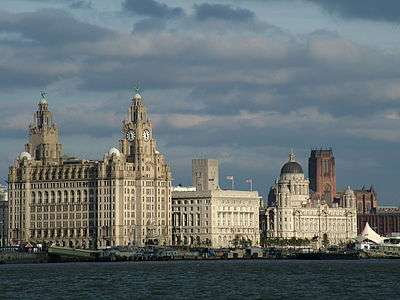
The sale of the former George's Dock in 1902 provided the basis for the development of Pier Head.[23] The ensemble of three administrative buildings eventually erected there, today constitute Liverpool's best recognised vista. Much later (some time around 2000) dubbed the Three Graces they are from north to south:
- Royal Liver Building (1908–11), surmounted by two bronze domes with a Liver Bird (the symbol of Liverpool) on each.
- Cunard Building (1914–17), the former headquarters of the Cunard shipping company.
- Port of Liverpool Building (1903–07), the home of the former Mersey Docks and Harbour Board which regulated the city's docks.
In front of these buildings at the water's edge are the memorials to the men of the Merchant Navy who sailed out of the port during both world wars. Memorials to the British mariners, Norwegian, Dutch and to the thousands of Chinese seamen who manned Britain's ships cluster together here. Perhaps most interesting is the Chinese memorial to the men forcibly deported from the city after the Second World War and to the families they left behind.[24]
Liverpool's wealth as a port city enabled the construction of two enormous cathedrals, both dating from the 20th century. The Anglican Cathedral, which was designed by Sir Giles Gilbert Scott and plays host to the annual Liverpool Shakespeare Festival. It has one of the longest naves, largest organs and heaviest and highest peals of bells in the world. The Roman Catholic Metropolitan Cathedral on Mount Pleasant next to Liverpool Science Park was initially planned to be even larger. Of Edwin Lutyens' gigantic original design, only the crypt was completed before it was abandoned in favour of a simpler design by Frederick Gibberd. While this is on a smaller scale than the Lutyens' scheme, it still manages to incorporate the largest panel of stained glass in the world. The road running between the two cathedrals is called Hope Street, a coincidence which pleases believers. Metropolitan Cathedral is colloquially also referred to as "Paddy's Wigwam" due to its shape and the vast number of Irishmen who worked on its construction and are living in the area.
In the south of the city, the art deco former terminal building of Speke Airport, used from the 1930s to 1986, has been adapted for use as an hotel, and is now the Crowne Plaza Liverpool John Lennon Airport. Speke was the first provincial airport in the UK, opened in 1933, and its restored terminal has been described as "still the most coherent example of the first generation of purpose-built airports remaining in Europe." The terraces from which fans welcomed home the Beatles have been preserved.
The Adelphi Hotel on Ranelagh Street is the most famous hotel in Liverpool and was very popular in the days when luxury liners crossed the Atlantic when it was described as the great Cunard liner stuck in the middle of the city. Liverpool was Charles Dickens' favourite city after London, and the Adelphi his favourite hotel in the world. A "fly-on-the-wall" TV documentary series was made on it and its staff.
On Renshaw Street there is the new alternative shopping centre Grand Central Hall which has not only fine external architecture but also has much to offer inside, such as the metalwork and ceiling decoration of the ground floor and the fantastic domed ceiling of Roscoe Hall. It was originally built in 1905, under the guidance of the Methodist Church, as a 2,000-seat cinema. The original organ of Roscoe Hall still remains and is a listed item itself, although recent shop additions to the hall have obscured the view somewhat.
Radio City Tower (also known as St. John's Beacon) is a radio and observation tower built in 1969 and opened by Queen Elizabeth II. Standing 452 feet (138 metres) tall, it was the tallest free-standing structure in Liverpool for decades.[25]
The Atlantic Tower Hotel, situated on Chapel Street next to Saint Nicholas' Church and near Pier Head, opened in 1972[26] and was designed to resemble the prow of a ship to reflect Liverpool's maritime history.
The largest of Liverpool's three mosques is the Al-Rahma mosque in the Toxteth area of the city.
The Art Deco, grade II* listed orthodox Greenbank Drive Synagogue (1936) in the Greenbank Park area has recently closed and is now at risk in a "poor" condition[27]
-
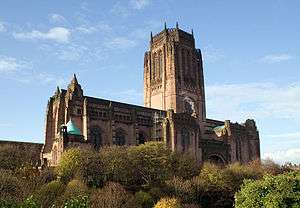
Liverpool Anglican Cathedral
(1901–78; Grade I)
The UK's largest cathedral -

Liverpool Anglican Cathedral
Interior -

Port of Liverpool Building
(1903–07; Grade II*) -

Royal Insurance Building
(1903; Grade II*)
Identified as the first steel-framed building in the UK -
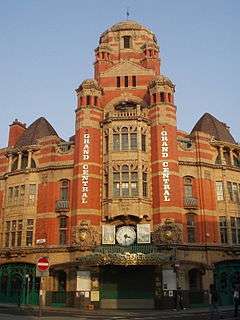
Grand Central Hall
(1905; Grade II) -

The Vines public house
(1907; Grade II*) -

Tower Buildings
(1910; Grade II*) -
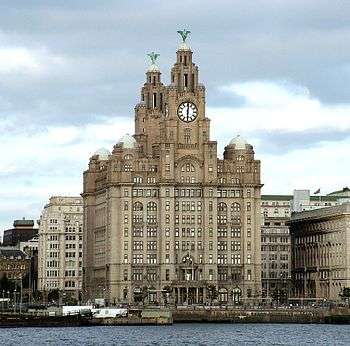
Royal Liver Building
(1908–11; Grade I)
Europe's first large reinforced concrete building, and the UK's largest clocks -

Adelphi Hotel
(1914; Grade II) -

Cunard Building
(1914–17; Grade II*) -
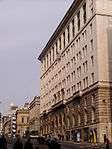
India Buildings
(1930; Grade II*) -
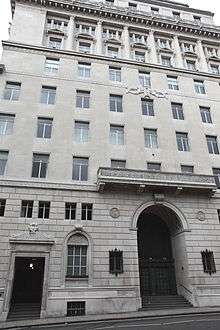
Martins Bank
(1932; Grade II*) -
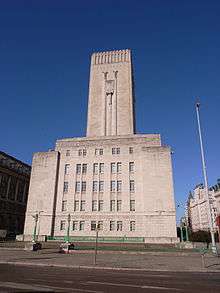
George's Dock Ventilation and Control Station, Pier Head
(1932; Grade II) -

Philharmonic Hall
(1939; Grade II*) -
.jpg)
Liverpool Metropolitan Cathedral
(1967; Grade II*) -

Radio City Tower
(1969) -

The interior of Greenbank Drive Synagogue (1936, Grade II*)
21st century

Liverpool's architectural schemes at the beginning of the 21st century are dominated by the city's bid to become the European Capital of Culture in 2008. This ambition led to its listing as a UNESCO World Heritage Site in 2004 and also to plans for redevelopment of Mann Island, the area between Albert Dock and Pier Head. Beating off illustrious competitors like Richard Rogers, Norman Foster and Edward Cullinan, in 2002, Will Alsop won the so-called Fourth Grace competition for the site and received the go-ahead with his project The Cloud.[28] By 2004, however, the project was scrapped[29] and alternatives sought.
Eventually, the waterfront position in front of the Cunard Building was taken by the Pier Head Ferry Terminal which was the winner of the 2009 Carbuncle Cup for "the ugliest building in the United Kingdom completed in the last 12 months".[30] The Museum of Liverpool by Danish architects 3XN took another waterfront position next to the Port of Liverpool Building and opened in 2011, while Broadway Malyan filled the Fourth Grace site with their banal Mann Island Buildings (2008–12).[31] Both projects were also shortlisted for the Carbuncle Cup in 2011 and 2012 respectively. The Mann Island Buildings also gave concern regarding some protected views onto the Three Graces.[32]
Other recent buildings in the dock areas include the Echo Arena Liverpool and BT Convention Centre which officially opened on 12 January 2008 in King's Dock immediately south of Albert Dock, and West Tower (2005–07), north-east of Pier Head, which at 40 storeys is currently Liverpool's tallest building, but soon to be dwarfed by the planned skyscrapers of Liverpool Waters. Situated in the northern docks, the Liverpool Waters redeveloment led to Liverpool's recently acquired status of World Heritage Site coming under scrutiny. Consequently, in 2012, Liverpool - Maritime Mercantile City was put on UNESCO's List of World Heritage in Danger.[33]
In recent years a number of creative architectural practices have been responsible for a number of innovative projects to revitalise the unused architectural fabric of the city. Notable, award winning, projects include the Greenland Street Gallery for the A Foundation and the Toxteth TV building. Both of these projects were by Liverpool design practice Union North.
-

West Tower
(2007) -
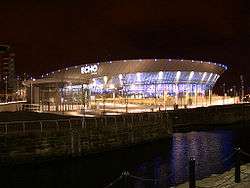
Echo Arena
(2008) -

Pier Head Ferry Terminal
(2009) -

Museum of Liverpool
(2011) -

Mann Island Buildings
(2012)
Gallery of views in the city
-

Liverpool waterfront at sunrise
-

Castle Street Liverpool, Bank of England to the right, NatWest Bank to the left, Liverpool Town Hall ahead
-

Liverpool's inner city has Georgian terraced streets. Wellington Rooms to the right, Royal Liver Building in the distance
-

Water Street, Liverpool, West Africa House and India Buildings to the right, Tower Buildings, Oriel Chambers, Martins Bank and Town Hall to the left, Royal Insurance Building and Prudential Assurance Building in the distance
-
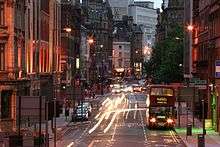
Victoria Street, Imperial Buildings, Midland Railway Goods Offices and General Post Office to the left, Bank of Liverpool to the right.
-

from left: Royal & SunAlliance Building (1976), Mersey Tunnel entrance (1934) (Grade II), Unity Residential (2007), Atlantic Tower Hotel (1974), Unity Commercial (2007), Our Lady and St.Nicholas' Church (1814) (Grade II), Mersey Chambers (1878) (Grade II)
-

A variety of architectural styles are present on the Strand in Liverpool city centre
-

Liverpool Commercial District
Parks and gardens
English Heritage National Register of Historic Parks describes Merseyside’s Victorian Parks as collectively the "most important in the country"[34] The city of Liverpool has ten listed parks and cemeteries, including two Grade I and five Grade II*, more than any other English city apart from London.
Liverpool School of Architecture
Liverpool has a long tradition of academic analysis in the field of architecture being home to both the first School of Architecture and the first University Department of Civic Design in the United Kingdom.[35]
Architects represented in Liverpool
Renowned architects are well represented in Liverpool, including Peter Ellis, John Wood, the Elder of Bath (commissioned in 1749 to design the original Public Exchange which later became the Town Hall), Thomas 'Greek' Harrison, James Wyatt, Harvey Lonsdale Elmes, Philip Hardwick, Jesse Hartley (Dock engineer and architect of the Albert Dock and Stanley Dock), Charles Cockerell, Thomas Rickman, John Foster, Augustus Welby Northmore Pugin, J.J. Scholes, Sir Joseph Paxton, Sir Giles Gilbert Scott, J.K. Colling, J.A. Picton, George Edmund Street, John Loughborough Pearson, E.W. Pugin, E.R. Robson, Edmund Kirby, Sir Edwin Lutyens, Sir Frederick Gibberd, Alfred Waterhouse (who was born in Aigburth), W.D. Caroe, Leonard Stokes, Norman Shaw, James Francis Doyle, Walter Aubrey Thomas (architect of the iconic Royal Liver Building on the Liverpool waterfront), Gerald de Courcy Fraser, Charles Reilly, the Audsley brothers and Herbert Rowse (architect of Martins Bank, Queensway Tunnel and India Buildings).
Quotes about Liverpool buildings
St. George's Hall
"The finest building in the world" Richard Norman Shaw[36]
"The most perfect hall in the world" Charles Dickens[37]
"Worthy of ancient Athens" Queen Victoria[38]
"The finest neo-classical building in Europe" Nikolaus Pevsner
Docks
"In Liverpool, I beheld long China walls of masonry; vast piers of stone; and a succession of granite-rimmed docks, completely inclosed, and many of them communicating, which almost recalled to mind the great American chain of lakes: Ontario, Erie, St. Clair, Huron, Michigan and Superior. The extent and solidity of these structures, seemed equal to what I had read of the old Pyramids of Egypt...In magnitude, cost and durability, the docks of Liverpool, even at the present day surpass all others in the world...For miles you may walk along that riverside, passing dock after dock, like a chain of immense fortresses..." Herman Melville, Redburn – his first voyage, 1849
Albert Dock
"For sheer punch, there is little in the early commercial architecture of Europe to emulate it." Nikolaus Pevsner
"the construction is for eternity, not time..." George Holt, 1845[39]
Anglican Cathedral
"This is one of the great buildings of the world... The impression of vastness, strength and height no words can describe... Suddenly one sees that the greatest art of architecture, that lifts one up and turns one into a king, yet compels reverence, is the art of enclosing space." John Betjeman, BBC broadcast, 1970[40]
Oriel Chambers
"One of the most remarkable buildings of its date in Europe." Nikolaus Pevsner, South Lancashire (The Buildings of England), 1969, p. 177.
"almost unbelievably ahead of its time", Nikolaus Pevsner, Pioneers of Modern Design, 1949.
"one of the most important buildings in the world" Quentin Hughes Seaport: Architecture and Townscape of Liverpool, 1964
St. James's Cemetery
"The cemetery was made in 1825-29 inside an abandoned quarry. The choice was a stroke of genius. It makes the cemetery the most romantic in England and forms an ideal foil for the cathedral next to it." Nikolaus Pevsner, South Lancashire (The Buildings of England), 1969
The Oratory
"one of the purest monuments of the Greek Revival in England", English Heritage
Town Hall
"Among English civic buildings of its date, Liverpool Town Hall is probably only second to London's Mansion House in its richness...This is probably the grandest such suite of civic rooms in the country, an outstanding and complete example of late Georgian decoration..." Sharples, 2004
"next to those in the Winter Palace in St. Petersburg, the best proportioned rooms in Europe" Prince of Wales, 1881[41]
Bank of England
"One of the masterpieces of Victorian commercial architecture, and among Cockerell's greatest works... Only three bays wide, but overwhelmingly massive and powerful." Sharples, 2004
Martins Bank
"This is the most remarkable bank interior in the country, and it would be wise for the chairmen of all the big banks to pay a visit to Liverpool in order to see it." Charles Reilly
"Rowse's masterpiece... and among the very best interwar classical buildings in the country." Sharples, 2004
India Buildings
"it would not disgrace Fifth Avenue; indeed it would sit there very happily and those who know most of modern architecture will know that this is very high praise." Charles Reilly
Princes Road Synagogue
"He who has not seen the interior of Princes Road synagogue in Liverpool has not beheld the glory of Israel." H.A. Meek, The Synagogue, 1995
Non-extant buildings and structures
Structures of particular architectural note which have been demolished or removed include the Custom House*, Overhead Railway, Goree Warehouses*, Sailors' Home, Central Station, the upper floors of the General Post Office*[42][43] and the facade of the Cotton Exchange.[44]
note: * indicates buildings which suffered bomb-damage during the Second World War, but, in the opinion of some, could have been restored.
Buildings never completed
In the 1920s, Liverpool's Catholic Archdiocese conceived a truly Brobdingnagian cathedral – larger than St Peter's, Rome – and commissioned the architect Edwin Lutyens to make the conception a reality.[45] It would have taken 200 years to complete. The Great Depression, the Second World War and Liverpool's subsequent economic decline meant it was never realised – only the crypt was completed – and in the 1960s Frederick Gibberd produced a different, cheap, yet innovative creation which sits atop Lutyen's crypt - Liverpool Metropolitan Cathedral.
Derelict Liverpool
Many fine buildings in Liverpool have sunk into decay, yet have not quite given up the unequal struggle against Nature, or are even being restored. Several authors have noted the Piranesian quality of such sites, which include the Williamson Tunnels, St. Andrew's Church,[46][47] Dingle railway station,[48][49] Lower Duke Street, St. James Cemetery[50][51] and the Edge Hill cutting and tunnels.[52][53]
-

86-90 Duke Street
(c. 1800) -
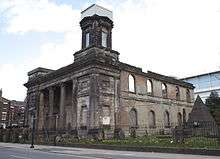
St. Andrew's Church, Rodney Street
(1823; Grade II*) -

Williamson tunnels (1810s-1830s)
-

Remnant of Peters' Building, 11 Rumford Street taken from Chapel Street (19th century)
-
Tunnel for Dingle railway station (1896)
See also
References
Notes
- 1 2 Hughes (1999), p10
- ↑ Hughes (1999), p11
- ↑ Pollard, Richard; Pevsner, Nikolaus (2006), The Buildings of England: Lancashire: Liverpool and the South-West, New Haven & London: Yale University Press, pp. 302–304, ISBN 0-300-10910-5
- ↑ "Listed buildings". Liverpool City Council.
- ↑ "Heritage map for changing city". BBC News. 19 March 2002. Retrieved 11 July 2009.
- ↑ Heritage at Risk register 2011 North West, pp. 66-69.
- ↑ Hughes, Quentin (1999). Liverpool City of Architecture. The Bluecoat Press.
- ↑ "Liverpool – Maritime Mercantile City". Archived from the original on 30 May 2008. Retrieved 26 May 2008.
- 1 2 Nomination of Liverpool - Maritime Mercantile City for Inscription on the World Heritage List, accessed 23/3/2013 (please note: this is a 450 page long pdf file!).
- ↑ Hughes (1999), p19
- 1 2 Hughes (1999), p20
- ↑ Cousens, Belinda Cousins (2006). Speke Hall. National Trust. p. 5.
- 1 2 Hughes (1999), p22
- ↑ "The Architecture of Croxteth Hall" (PDF). Liverpool City Council. Retrieved 8 February 2010.
- ↑ Hughes (1999), p21
- ↑ Images of England: Bluecoat Chambers, English Heritage, retrieved 2008-10-11
- ↑ Heritage at Risk register 2011 North West, pp. 66.
- ↑ Hughes, Quentin (1999). Liverpool: City of Architecture. Bluecoat Press.
- ↑ Q. Hughes, Seaport, Bluecoat Press, 1993, p.62.
- ↑ Peers, Edgar Allison (1943). Redbrick University.
- ↑ Sharples, Joseph, Pevsner Architectural guide to Liverpool, Yale University Press, 2004, p. 249
- ↑ "Liverpool's Jewish heritage". Archived from the original on 6 February 2007. Retrieved 13 May 2007.
- ↑ Deeds documenting history of Liverpool’s Three Graces discovered by antique dealer, Liverpool Echo, Jul 25 2011.
- ↑ "Liverpool and its Chinese Seamen". Archived from the original on 31 May 2008. Retrieved 28 May 2008.
- ↑ Skyscraper News tallest buildings and structures search form
- ↑ wego
- ↑ Heritage at Risk register 2011 North West, pp. 67.
- ↑ Fourth Grace favourite revealed. BBC News,6 Dec 2002
- ↑ Fourth Grace plans 'unworkable'. BBC News,19 July 2004
- ↑ [Alan Weston, http://www.liverpoolecho.co.uk/liverpool-news/local-news/2009/08/27/liverpool-pier-head-ferry-terminal-voted-britain-s-ugliest-building-100252-24548157/ Liverpool Pier Head Ferry Terminal voted Britain's ugliest building], Liverpool Echo, Aug 27 2009.
- ↑ In place of Grace, bdonline 2006 issue 09.
- ↑ Ben Schofield, Liverpool’s Three Graces views blocked by Mann Island build, Liverpool Echo, Apr 26 2010.
- ↑ Liverpool – Maritime Mercantile City, World Heritage in Danger.
- ↑ "Dr. Peter Brown, chair, Merseyside Civic Society" (PDF). Retrieved 12 January 2012.
- ↑ Couch, Chris (2002). Design Culture in Liverpool: 1880–1914. Liverpool University Press. p. 9.
- ↑ The Architects' Journal, v.192, 1990, p6
- ↑ Dolby, George (1887). Charles Dickens as I knew him. Routledge. ISBN 978-0-415-22233-4.
- ↑ Tytler, Sarah (1885). Life of Her Most Gracious Majesty the Queen, Vol II.
- ↑ Coles, Gladys Mary (1997). Both sides of the river:Merseyside in poetry and prose. Headland Publications. p. 71.
- ↑ Coles, Gladys Mary (1997). Both sides of the river:Merseyside in poetry and prose. Headland Publications. p. 234.
- ↑ Forwood, William Bower (1910). Recollections of a busy life. Liverpool: Henry Young & Sons.
- ↑ "Streets of Liverpool Blog". Streetsofliverpool.co.uk. 1 March 2011. Retrieved 12 January 2012.
- ↑ Postal, British (15 October 2010). "Flickr photo". Flickr.com. Retrieved 12 January 2012.
- ↑ Liverpool Wiki Archived 23 May 2009 at the Wayback Machine. Liverpool's Destroyed or Demolished Landmarks
- ↑ The Greatest Building Never Built architectural blog, 11 Jan 2007
- ↑ "St. Andrew's Church". Liverpoolviews.co.uk. Retrieved 12 January 2012.
- ↑ "Report on the Pyramid in St Andrew's Scotch Church Liverpool". Ancient-egypt.co.uk. 31 August 2008. Retrieved 13 December 2011.
- ↑ "Urbex Forums". Retrieved 12 January 2012.
- ↑ "Urbex Forums". Urbex Forums. 25 May 2008. Retrieved 12 January 2012.
- ↑ "St. James's Cemetery". Retrieved 12 January 2012.
- ↑ "St. James's Cemetery". Retrieved 12 January 2012.
- ↑ "Subterranea Britannica". Subbrit.org.uk. 4 January 2011. Retrieved 12 January 2012.
- ↑ "Subterranea Britannica". Subbrit.org.uk. 4 January 2011. Retrieved 12 January 2012.
Bibliography
- Hughes, Quentin (1999). Liverpool: City of Architecture. Bluecoat Press. ISBN 1-872568-21-1.
External links
- History of Georgian Liverpool
- Providing the full history on St Luke's 'Bombed Out' Church
- Archiseek - Liverpool Architecture
- Providing the full history on St Luke's 'Bombed Out' Church
- Showcasing the City of Liverpool's Buildings
- Liverpool World Heritage Website
- A Masterpiece for Merseyside Time Magazine, 13 Nov 1978
- Flickr photo set
- The Mersey Tunnel – Vintage page from 1937
- English Heritage Viewfinder 700 historical photos of Liverpool buildings
- Ward Lock Guide to Liverpool, excerpts, published 1949
- Liverpool's destroyed landmarks, from Liverpool Wiki
